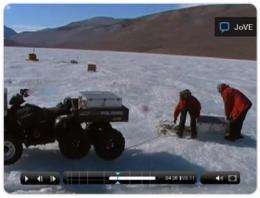Carbon-consuming life-forms in Antarctica

Lake Bonney in Antarctica is perennially covered in ice. It is exposed to severe environmental stresses, including minimal nutrients, low temperatures, extreme shade, and, during the winter, 24-hour darkness. But, for the single-celled organisms that live there, the lake is home. To study them, Dr. Rachel Morgan-Kiss from the University of Miami, Ohio, and her team went to Antarctica to sample the ice-covered lake. The article describing her method will be published April 20, in the JoVE (the Journal of Visualized Experiments).
"Our laboratory has a focus on understanding adaptations in extreme environments," said Dr. Morgan-Kiss. "Ice-covered lakes are much simpler to study than typical aquatic environments because all of the organisms in the lake are microbial. They are at both the top and the bottom of the food chain."
Despite being microscopic, these organisms may play a big role in global climate change. Many of them have a mixotrophic metabolism, meaning that they survive either by fixing carbon, like plants, or by eating other protists (single-celled microbial eukaryotes). However, it's not known what causes these organisms to display one type of metabolism over another.
Moreover, it is not known how the climate effects this metabolic switch. If climate change causes more episodic weather events (like storms), nutrients will be stirred up from the bottom of lakes and oceans. This could have a huge impact on protist metabolism and climate change overall.
To help answer this question, Dr. Morgan-Kiss and her team took samples from different parts of the lake— the top, middle, and bottom— where the nutrient to sunlight ratios in the lake vary. The top gets plenty of sunlight, but there are few nutrients; the middle of the lake has moderate amounts of both; and the bottom gets little sunlight but is nutrient-rich.
"This interesting video-article produced by the JoVE Video team helps show exactly how scientists navigate in this challenging environment" says Dr. Beth Hovey, JoVE Editorial Director. "Research in Antarctica can add a great deal of insight in the realm of climate change. By opening a window into how to conduct science in extreme environments, Dr. Morgan-Kiss and her colleagues are helping advance this field of study."
Journal information: Journal of Visualized Experiments
Provided by The Journal of Visualized Experiments
















